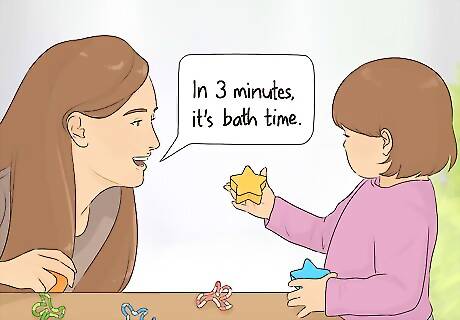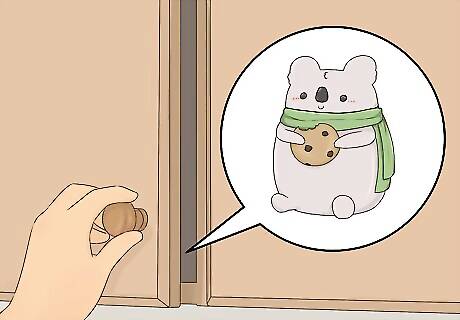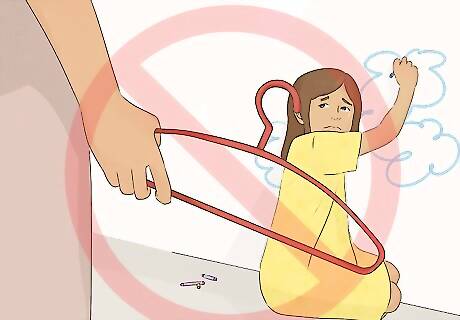
views
Communicating During the Tantrum

Speak in an even, compassionate tone during a tantrum. An upset child usually won’t respond well to an angry, impatient tone of voice. Instead, harsh tones may distress the child even further and worsen or prolong the temper tantrum. Step back or turn away from the child for a few seconds to collect your thoughts if you are aggravated or upset. It’s important to model the calm behavior you want to instill in your child. “Gerald, stop throwing blocks” is more effective than “Hey! Stop throwing blocks right now!”

Use short phrases when speaking to an upset toddler. It is easier for a child to hear and comprehend 2 or 3 words spoken at a time than an entire sentence. A simple command such as “Stop kicking that” will be better understood than a sentence like “I want you to stop kicking that before you break it.” If your child understands what you expect from them, they are less likely to start or continue a temper tantrum out of frustration. Sometimes a child will respond better if you tell them what you want them to do, instead of reprimanding them by telling them not to do something. An example would be to tell a child to "Walk, please" instead of saying "Don't run.”

Repeat your desires again and again. Often, children are so caught up in themselves that they are not immediately aware of what is being said to them. If this is the case, repetition will work to get your point across and potentially prevent a temper tantrum. Keep the same calm, even tone each time you repeat yourself, instead of getting louder and more irritated each time. Just keep saying something like “Hector, it’s time to put your pajamas on.”

Acknowledge the child’s feelings. After you have expressed the clear need for the behavior to stop, convey in simple language that you understand their emotions in this case. A child will be more likely to respond in a positive manner and listen further when you tell them that you understand why they are upset. Say something like “I know how frustrating it can be when someone else is playing with the toy you want, Tonya.”

Diagnose the likely cause of the tantrum if it isn’t obvious. Generally, a child is more apt to have a meltdown if they are feeling out of sorts in one way or another. Hunger and fatigue can cause children to become cranky. Frustration can send a child into an outburst. Children who have not yet learned how to control their emotions will react by acting out the only way that they know how. So, when dealing with an unexplained meltdown, replace “I don’t know why you’re acting like this!” with “I know being tired makes everything more difficult.” Let the child know that it is okay to feel what they are feeling, such as by saying, “It’s okay to feel angry sometimes.”

Reassure them that you are aware of their needs. Often a child will use a tantrum to get the attention they are looking for. This is especially true in toddlers just learning to speak. They have a lot to say but are unable to express themselves in a way others can understand. Say something along the lines of “Show me why this puzzle is frustrating you so much” or “Use your words to tell me why you are upset with your brother.” You may also want to offer the child an alternate activity to help them express their emotions. For example, if the child is hitting you because they are angry, say something like, “It’s not okay to hit people when you feel angry. Hit a pillow instead.”

Empathize with your child’s desire for independence. Children naturally want to emulate the world around them. Unfortunately, the things they often wish to do are often beyond their capabilities or are unsafe for them. Validate their frustration without treating their tantrum as an acceptable response to it. Climbing the stairs or swimming on their own are good examples. They struggle for the independence to do these things, unaware of the dangers that accompany these tasks. Say something like “I know you want to climb the steps by yourself, and you will be able to someday soon. But we need to be calm now.”
Preventing Temper Tantrums

Anticipate tantrums based on your child’s personality and history. Some children naturally have a calm, relaxed disposition, and have infrequent tantrums. Others are higher strung, moody, and hyperactive, and are more apt to have regular outbursts. Base your prevention strategies on the frequency and timing of tantrums that the child has shown previously. If the child has infrequent tantrums, it may be easier to pinpoint specific scenarios—such as being cooped up in the car for hours—that trigger them. If the child has regular tantrums, it may be more useful to look for physical or emotional signs of an oncoming tantrum, as opposed to trying to predict what circumstances might cause one. You can also anticipate and distract the child from their tantrum triggers. For example, if your child is triggered by cleanup time, then you might take them into another room while someone else cleans up.

Transition between tasks to make interruptions or changes less jarring. If the child becomes agitated when you stop an activity for bath time or dinner, they may be more prone to outbursts. Understanding this can help you develop a more effective way to transition from one activity to another, which can help prevent tantrums. Announce the upcoming change more than once: “In 5 minutes, it will be time for your bath,” then “In 2 minutes…” Turn the transition into its own activity: “We have 3 minutes until dinner time. Let’s see if we can get all the blocks put away by then!”

Build their sharing skills if sharing problems cause tantrums. Take notice of how well the child shares with other children. If you see that they have a particular difficulty with sharing, work on their social skills and try to incorporate sharing into their playtime routine. When dealing with 2 children, introduce sharing as a trade-off: “You’ll play with the rocket ship for 5 minutes, then you’ll switch toys with Ben and play with the race car for 5 minutes.” Never miss an opportunity to praise them for sharing: “Thank you so much for sharing your crayon with your sister, Johanna!”

Know your child’s limits and avoid pushing your luck. Sometimes you can avoid things that often trigger a child’s tantrums. But you can’t alter everything in your life to avoid every tantrum scenario—for instance, long car trips or going to the grocery store. You may, however, be able to limit the length of your car trips or reduce the frequency of your grocery trips. If you know that keeping your child out past their normal bedtime usually results in a tantrum, try to adjust your social calendar to suit this reality, or look into using a babysitter so your toddler can stay on schedule.

Place items that you know will cause a tantrum out of your child’s sight. If they throw a fit because they can’t have a cookie, keep the cookie jar in the cupboard instead of on the countertop. If a certain toy always seems to cause a sharing problem during a playdate, quietly stash it away for awhile and replace it with other options. Replacing the object with another alternative can be very helpful. Maybe you could replace the cookie jar on the counter with a bowl of apples, for instance.

Use distraction as a way to prevent a tantrum. Toddlers are easily distracted, so use it to your advantage the moment you suspect that a temper tantrum may be on the horizon. Suggest a game you can play together, ask a simple question, or simply point out a random observation. You might say “Tom, do you want to build a train track with me?” or “Hey, look, there’s a blue jay on the fence in the yard.”

Attempt to incorporate humor into a tense or stressful situation. Children will often forget what is upsetting them if you can get them to laugh before a temper tantrum begins. Try saying or doing something silly out of the blue. Put a bowl on your head and ask “Do you like my new hat?” or blurt out “Let’s have a silly face contest—what do you think of this one?”
Taking Action While Avoiding Mistakes

Steer clear of bribing a child to prevent a tantrum. All this will do is set the stage for future tantrums. For instance, if you can tell a tantrum is coming on in the store, don’t say “Stay calm and I’ll get you that toy you wanted.” However, setting up a reward beforehand for good behavior is a viable strategy. Before you even go to the store, you might say “If you stay calm and listen the whole time we’re in the store, I’ll buy you that toy you want.” But stick to the deal and don’t cave in if they don’t keep up their side of the bargain.

Don’t cave in to the child just to end a temper tantrum. As with bribery to stop an imminent tantrum, all the child will learn from your caving in is that throwing a tantrum will get them what they want. The next time they may throw an even bigger tantrum just to get their way. Remain calm, keep communicating what needs to occur clearly, and act only to prevent harm or if removing the child from the situation is necessary. You might, however, be able to accommodate them without necessarily giving in to them. For instance, if they’re throwing a fit because they want ice cream, try something like “No ice cream, but you can have some of that yummy yogurt you like with blueberries on top.”

Step in and remove a child from harming themselves or others. Place the child in a safe place away from others. If you must restrain them physically, hold them firmly until they have calmed down enough to let them go. Some children will kick and hit and struggle to get free from the restraint. Protect yourself as best as possible and remain determined and calm. Speak calmly and reassuringly throughout the process: “I know you’re upset right now, but everything will be OK. Let’s both try to calm down together.”

Don’t use physical punishment to get your point across. The only message you send is that physical punishment is an acceptable way to handle anger. Chances are all that you will accomplish is more negative behavior and more temper tantrums. Worst of all is spanking a child in anger or frustration during a tantrum. All you’re doing then is punishing them for being unable to control their emotions by being unable to control yours. If your blood is boiling, take a step back or turn away for a few moments. If disciplinary action is warranted, use something that’s more effective on toddlers, like a time-out. One minute of time-out per year of age is a good general guideline.

Keep all caregivers on the same page in dealing with tantrums. You, as a parent, might use calm communication to work through tantrums. However, if the other parent shouts angrily and the babysitter caves in immediately, the mixed messages will confuse the child and may make the tantrums worse. Discuss your tantrum strategy with any co-parents and reach a common arrangement, and make sure any sitters or other caregivers are clear on your expectations for dealing with tantrums. This can be more of a challenge if you and the other parent aren't a couple. If you can't change how they deal with the child's tantrums, it's still important for you to stick to using calm, informed methods.

Seek out professional help if the tantrums are out of control. If all your attempts to prevent or curtail temper tantrums seem to be failing, talk to the child’s doctor about the situation. They can check for any physical issues that may be exacerbating the tantrums, and possibly refer you to a child psychologist or other licensed therapist who may be able to help out. Developmental delays might make tantrums worse, as might things like visual or hearing impairments, which might not be immediately obvious with a toddler. Never feel as though you’ve “failed” or “given up” by seeking professional help. You’re doing exactly what you should be as a caring adult.


















Comments
0 comment